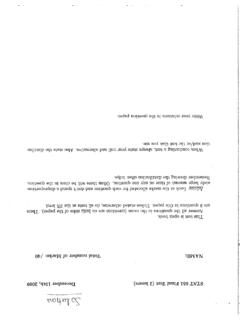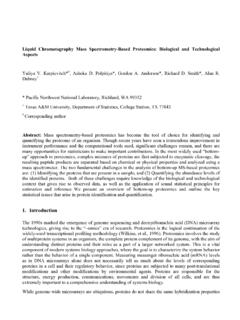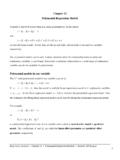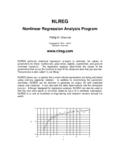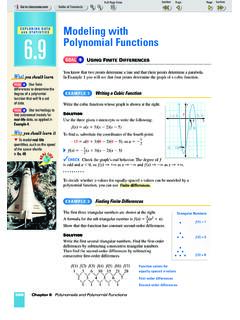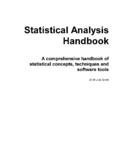Transcription of Type I and II sums of squares - Home - Dept. of …
1 Type I and II sums of squaresAt least four types of sums of squares will discuss two of these, the so calledTypeIandType IIsums of squares . The differencebetween the two is explained I sums of squaresThese are also calledsequential sums of is one sum of squares (SS) for each vari-able in one s linear model. These are given inSPSS in the form of an ANOVA SS is the amount SSR goes up when thevariable in a given line is added to a modelcontaining all variables on previous lines butno our reduction method notation, the SSon the first line isSSR( 1), the SS on thesecond line isSSR( 2| 1), the SS on the thirdline isSSR( 3| 1, 2), and so : TheF-statistic for a given line tests thehypothesis that the variable on that line isnot needed in a model with thepreviousvariables.
2 The Type I sums of squares add up to SSR,the regression sum of squares for the modelcontaining all the independent variables. The Type I sums of squares are differentdepending upon the way the independentvariables are II sums of squaresThe SS for a given independent variable, sayxj, isSSR( j|all other variables).In other words, this is the reduction sum ofsquares that would be used to test the nullhypothesisH0: j= : The Type II sums of squares don t neces-sarily add up to SSR. The Type II sums of squares do not de-pend on the ordering of the may obtain Type I and II SS in SPSS usingtheGeneral Linear Modeloption as follows: Choose theUnivariateoption.
3 Move your response variable toDependentVariableand each independent variable toCovariate(s). ClickModeland then theCustombutton. Move each independent variable into Choose which type of SS you want withthe drop down menu. Keep in mind that ifyou choose Type I, the values you get willdepend on the order in which you placeyour independent variables in theModelwindow. ClickContinueand method for choosing polynomial a maximum degree for the polyno -mial model. Only in rare cases would youchoose the maximum larger than Linear Model (Univariate), Define a model containing all powers ofxup to and including the maximum cho-sen in 1.
4 Make sure the independent variables arein order from smallest to largest powerofx. Choose Type I SS as described on theprevious will be anF-statistic in the outputcorresponding to each Type I SS. Chooseas your polynomial degree the first one suchthat (i) it sF-test is significant (at somespecified level) and (ii) the next twoF-tests are not :There is no guarantee that this methodwill always choose the correct polyno -mial degree. Make sure you look at plotsof the data and the fitted polynomial toavoid choosing a poor : Another method for choos-ing polynomial degreeLetR2kbe theR2value for thekth degree poly-nomial model.
5 Then it is always true thatR21 R22 .So, choosing polynomial degree to maximizeR2is a very unreliable method. (We wouldalways choose the largest degree polynomialunder consideration.)TheadjustedR2value for a model withkin-dependent variables isR2adj,k= 1 (1 R2k)(n 1n k 1).This adjustment toR2penalizes models witha large number of independent variables. Auseful guide for selecting polynomial degree isto consider models with the largest values adjustedR2for rabbit of independent variableSometimes it s worthwhile totransformtheindependent variable(s) before fitting a linearmodel.
6 This can possibly yield better fittingmodels, in the sense of largerR2values and/ormore sensible looking estimates of the curve the rabbit data, we have definedx= s defineu= x, and consider polynomialmodelsy= 0+ 1u+ 2u2+ + mum+ .Such a model may be obtained in SPSS bydefining the variablesu, u2, .. , umwithTrans-formandCompute Variables, as discussed pre-viously in adjustedR2for polynomialmodels in xfor rabbit though the adjustedR2is a bit biggerfor the 6th degree model than the 4th degree.
7 I prefer the 4th degree on aesthetic the estimated curves on next in xfor rabbit data degree model degree model degree model degree model degree model degree modelThe 4th degree model hasR2= Thisis slightly larger than theR2for the previous4th degree model. In addition, the 4th degreemodel based on xis more aesthetically pleas-ing; it doesn t have the artificial dip nearx= 1that the other 4th degree

